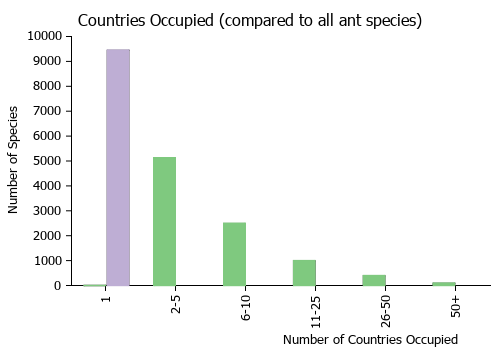Eurhopalothrix hoplites
| Eurhopalothrix hoplites | |
|---|---|
| Scientific classification | |
| Kingdom: | Animalia |
| Phylum: | Arthropoda |
| Class: | Insecta |
| Order: | Hymenoptera |
| Family: | Formicidae |
| Subfamily: | Myrmicinae |
| Tribe: | Attini |
| Genus: | Eurhopalothrix |
| Species: | E. hoplites |
| Binomial name | |
| Eurhopalothrix hoplites Taylor, 1980 | |
The type was collected from a rainforest berlesate sample.
Identification
Similar to Eurhopalothrix procera and Eurhopalothrix greensladei. Both are abundantly distinct from E. hoplites. They have relatively broad heads (CI 106-110 and 110-114 respectively), less evenly convex mesosomal dorsa, viewed laterally, much weaker postcephalic sculpture, and a pair of specialised erect hairs each on the verticocciput and pronotum at least. (Taylor 1980)
Keys including this Species
Distribution
Latitudinal Distribution Pattern
Latitudinal Range: -3.683330059° to -3.683330059°.
| North Temperate |
North Subtropical |
Tropical | South Subtropical |
South Temperate |
- Source: AntMaps
Distribution based on Regional Taxon Lists
Indo-Australian Region: New Guinea (type locality).
Distribution based on AntMaps
Distribution based on AntWeb specimens
Check data from AntWeb
Countries Occupied
| Number of countries occupied by this species based on AntWiki Regional Taxon Lists. In general, fewer countries occupied indicates a narrower range, while more countries indicates a more widespread species. |

|
Estimated Abundance
| Relative abundance based on number of AntMaps records per species (this species within the purple bar). Fewer records (to the left) indicates a less abundant/encountered species while more records (to the right) indicates more abundant/encountered species. |

|
Biology
|
Castes
Nomenclature
The following information is derived from Barry Bolton's Online Catalogue of the Ants of the World.
- hoplites. Eurhopalothrix hoplites Taylor, 1980b: 231, figs. 1-3 (w.) NEW GUINEA.
Unless otherwise noted the text for the remainder of this section is reported from the publication that includes the original description.
Description
Worker
Dimensions (holotype cited first).-TL ca 4.8,4.5; HL 1.06, 1.05; HW 1.08, 1.01; CI 102, 96; ML 0.23, 0.22; M122, 21; SL 0.63, 0.62; SI 58, 57; maximum diameter of eye 0.08, 0.09; PW 0.72, 0.69; WL 1.17, 1.18; petiolar node width 0.36, 0.34; postpetiole width 0.69, 0.64; gastral width 0.92, 0.89.
Outer borders of mandibles feebly concave, basal tooth unspecialised. Front of head almost entirely and evenly convex, except for a slight transverse impression across the median fronto-clypeal region. Mesosomal profile broken only by slight indentations between its pronotal, mesonotal and propodeal sections. Promesonotal suture represented dorsally by a slight depression which does not break the sculpture; metanotal groove slightly more distinct. Ventral carinae of petiole not serrated. Postpetiole almost lacking a median longitudinal depression.
Head, mandibles and scapes feebly shining, with a dense, largely effaced fine punctate-rugosity, more distinct on mandibles, clypeus and scapes. Mandibular teeth minutely transversely arched-striate. Antennal fossae smooth and shining, with traces of transverse carinae posteriorly. Dorsa of mesosoma, petiole and postpetiole coarsely punctate-rugose; sides of mesosoma similar, except the mes- and metepisternites, which are smooth and shining, with a few ventral punctures. First gastral tergite generally smooth and shining, with scattered small punctures and narrow anterior and lateral strips of dense, fine puncturation. The more distal tergites similarly densely punctate. First gastral sternite more coarsely punctate, with a smooth, shining median disc. Legs almost entirely finely punctate-rugose, the sculpture partly effaced on the coxae.
Specialised erect hairs lacking except for a few on leading edges of scapes, and on gastral apex; a few on first gastral sternite, none on its tergite. Ground pilosity of dense, short, yellowish-white hairs associated everywhere with the punctate-rugose sculpturing, lacking where it is absent, except on gastral dorsum, where hairs are minute. Dense fine pubescence limited to antennal funiculi.
Rich deep mahogany-brown, appearing black to the naked eye; antennae and legs a shade lighter.
Type Material
Papua New Guinea: Sepik Province: Passam, near Wewak, berlesate, rain forest, ca 270 m, 5.vii.1972, RWT, paratype worker (Australian National Insect Collection). Central Province: Lejo Rd, near Popondetta (Type Locality), 9.vii.1973, PMR, hololype worker (ANlC, Type No. 7521).
References
- Taylor, R. W. 1980b. Australian and Melanesian ants of the genus Eurhopalothrix Brown and Kempf - notes and new species (Hymenoptera: Formicidae). J. Aust. Entomol. Soc. 19: 229-239 (page 231, figs. 1-3 worker described)
References based on Global Ant Biodiversity Informatics
- CSIRO Collection
- Janda M., G. D. Alpert, M. L. Borowiec, E. P. Economo, P. Klimes, E. Sarnat, and S. O. Shattuck. 2011. Cheklist of ants described and recorded from New Guinea and associated islands. Available on http://www.newguineants.org/. Accessed on 24th Feb. 2011.
- Taylor R. W. 1980. Australian and Melanesian ants of the genus Eurhopalothrix Brown and Kempf - notes and new species (Hymenoptera: Formicidae). Journal of the Australian Entomological Society 19: 229-239.